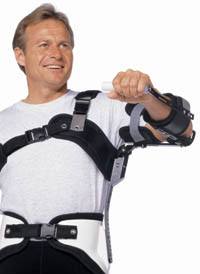Nerve Disorders
Muscular Dystrophy
The Shoulder in Patients With Muscular Dystrophy
Stephen A. Copeland, FRCS; Ofer Levy, MD; Giles C. Warner, MBBS; Ron M. Dodenhoff, FRCS Shoulder Surgery Unit, Royal Berkshire Hospital, Reading, UK.
Shoulder weakness and instability are not usually a major part of the clinical picture of muscular dystrophies. Problems usually do not arise until the patient is wheelchair bound, at which time assistive appliances may be required. The majority of orthopaedic intervention is confined to the rare facio-scapulo-humeral dystrophy. Facio-scapulo-humeral dystrophy causes muscular weakness of the face, shoulder girdle, and upper arm with selective sparing of the deltoid muscle. This leads to scapular winging and a marked decrease in flexion and abduction of the shoulder. As the muscles stabilizing the scapula become involved, the scapula starts to wing. The deltoid is spared, but its action is wasted because of the unstable scapula. The deltoid contracts and the arm attempts to move in a normal fashion, but because the scapula is no longer stable, it wings and rotates under the forces of the long lever arm of the upper limb and scapula complex. Mechanical fixation of the scapula to the thoracic wall provides a stable fulcrum on which the deltoid can exert its powerful action on the humerus and abduct the arm without rotation of the scapula. Twenty thoraco-scapular fusions were performed on 13 patients. Ten patients (14 shoulders) were available for long term follow-up. The long term results showed that this operation is successful in achieving stability of the scapula, while greatly improving function and cosmesis. Although the course of this type of muscular dystrophy is variable, the benefits of surgery have not deteriorated with progression of the disease during a maximum follow-up of 44 years.
CLINICAL ORTHOPAEDICS AND RELATED RESEARCH; Number 368, pp. 80—91 © 1999 Lippincott Williams & Wilkins, Inc.
The type of brace used for 3 months after surgery

You will need the Adobe Reader to view and print these documents. 
